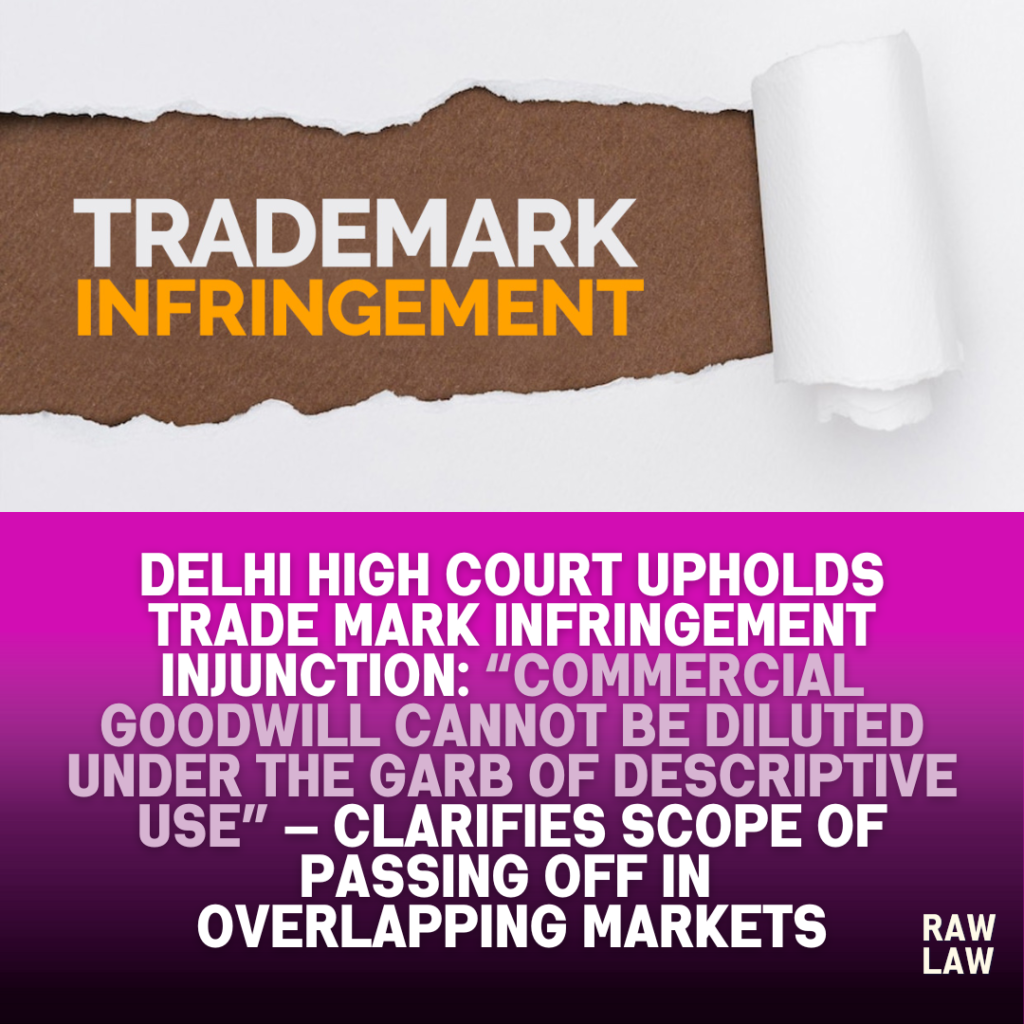Court’s Decision
The Delhi High Court dismissed the appeal challenging an injunction restraining the appellant from using a deceptively similar trade mark in relation to overlapping goods and services. The Court held that the defendant’s use amounted to infringement under the Trade Marks Act and constituted passing off, as the similarities in marks, nature of goods, and trade channels created a clear likelihood of confusion. It reiterated that commercial goodwill built over decades cannot be diluted merely on the plea of descriptive or generic use, especially when the impugned mark adopts the essential features of a registered mark. The injunction granted by the Single Judge was thus affirmed.
Facts
The plaintiff, an established trade body with extensive reputation and a registered mark, alleged that the defendant adopted an identical or deceptively similar mark for events, publications, and promotional activities in the same or allied sectors. The plaintiff claimed long-standing use of the mark since the pre-liberalisation era, supported by substantial documentary evidence, media coverage, and international recognition. The defendant argued that the term was generic/descriptive and in public domain, that there was no overlap in core services, and that its use was honest without intent to mislead. The Single Judge found the plaintiff’s goodwill to be established and restrained the defendant. Aggrieved, the defendant appealed.
Issues
- Whether the defendant’s use of the mark constituted infringement under Section 29 of the Trade Marks Act, 1999.
- Whether the defendant’s activities amounted to passing off by misrepresentation likely to cause confusion.
- Whether the defence of generic/descriptive use under Section 30(2)(a) could shield the defendant from injunction.
- Whether the overlap in trade channels and class of consumers was sufficient to infer likelihood of confusion.
Petitioner’s (Appellant’s) Arguments
The appellant contended that the disputed term was a common industry expression not capable of exclusive appropriation. It claimed its activities catered to a distinct niche and that consumers in its sector were discerning, thus unlikely to be confused. It relied on prior use in different contexts by other entities and argued that the respondent had not objected to such uses earlier, indicating acquiescence. It further argued that the Single Judge had overextended the scope of Section 29 by equating mere similarity with infringement without proof of actual confusion.
Respondent’s (Plaintiff’s) Arguments
The respondent maintained that its mark had acquired a secondary meaning strongly associated with its organisation, transcending the literal meaning of the words. It stressed the extensive evidence of brand recognition, including government endorsements, foreign collaborations, and consistent use over decades. The plaintiff contended that the defendant’s adoption was dishonest, intended to ride on its goodwill, and that even sophisticated consumers could be misled when identical marks were used in overlapping or allied sectors. It cited settled law that actual confusion need not be proved; likelihood is sufficient for injunction.
Analysis of the Law
The Court emphasised that the Trade Marks Act protects not just identical goods but also allied and cognate goods/services where consumer confusion is likely. Section 29(4) extends protection to well-known marks even for dissimilar goods if goodwill is established. The Court underscored that descriptive use under Section 30 is permissible only when such use is honest and not as a trade mark. The defendant’s manner of presentation, logo stylisation, and market positioning demonstrated an intent to identify its offerings with the disputed mark rather than merely describe services.
Precedent Analysis
The Court relied on:
- Cadila Health Care Ltd. v. Cadila Pharmaceuticals Ltd. — reaffirming that the test of deceptive similarity considers the mark as a whole and the likelihood of confusion among an average consumer of imperfect recollection.
- Laxmikant V. Patel v. Chetanbhai Shah — reiterating that in passing off, actual deception need not be shown; likelihood suffices.
- ITC Ltd. v. Punchgini Inc. — highlighting that goodwill is a proprietary right protectable even absent physical goods overlap.
- T.V. Venugopal v. Ushodaya Enterprises Ltd. — stressing that even generic terms may acquire distinctiveness through long and exclusive use.
Court’s Reasoning
The Court found that the plaintiff’s mark had attained the status of a source identifier well beyond its descriptive sense. The overlapping trade channels, shared event spaces, and similar target consumer base increased the potential for confusion. The appellant’s adoption was not innocent, as the mark was stylised and promoted in a manner closely echoing the plaintiff’s brand presentation. The Court rejected the argument of niche markets, observing that in modern commerce, sectors often overlap due to diversification and cross-sector branding.
Conclusion
The appeal was dismissed, and the injunction against the appellant was upheld. The Court reiterated that protection of established goodwill is central to trademark jurisprudence and that infringing use in allied fields cannot be justified under the shield of generic expression.
Implications
This ruling strengthens brand protection by affirming that:
- Even descriptive/generic words can gain exclusive protection through secondary meaning.
- Passing off can occur without identical goods if trade channels overlap.
- Section 30 defences will be narrowly construed where presentation indicates branding rather than description.
Brief on Cases Referred
- Cadila Health Care Ltd. v. Cadila Pharmaceuticals Ltd. — applied for the test of deceptive similarity.
- Laxmikant V. Patel v. Chetanbhai Shah — cited for the principle that likelihood of deception suffices in passing off.
- T.V. Venugopal v. Ushodaya Enterprises Ltd. — invoked to show that generic words may acquire distinctiveness.
- ITC Ltd. v. Punchgini Inc. — relied upon to extend goodwill protection to allied sectors.
FAQs
Q1. Can a descriptive term be protected as a trademark?
Yes, if it has acquired a secondary meaning linking it to a particular source, even descriptive terms can receive protection.
Q2. Is proof of actual confusion necessary in passing off?
No, likelihood of confusion is sufficient for injunctive relief.
Q3. Can an injunction extend to allied services beyond the goods for which the mark is registered?
Yes, if goodwill is established and there is a likelihood of confusion in overlapping trade channels.



